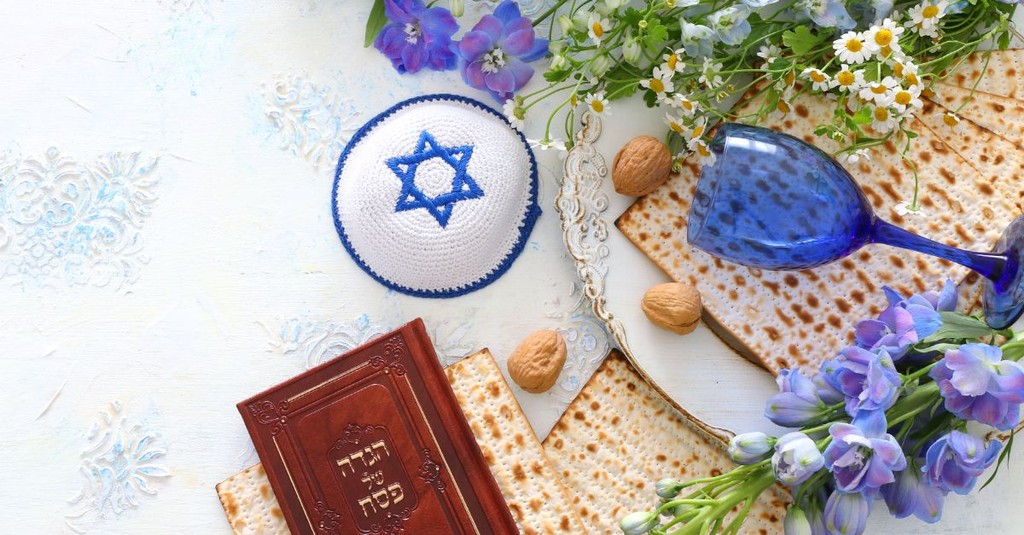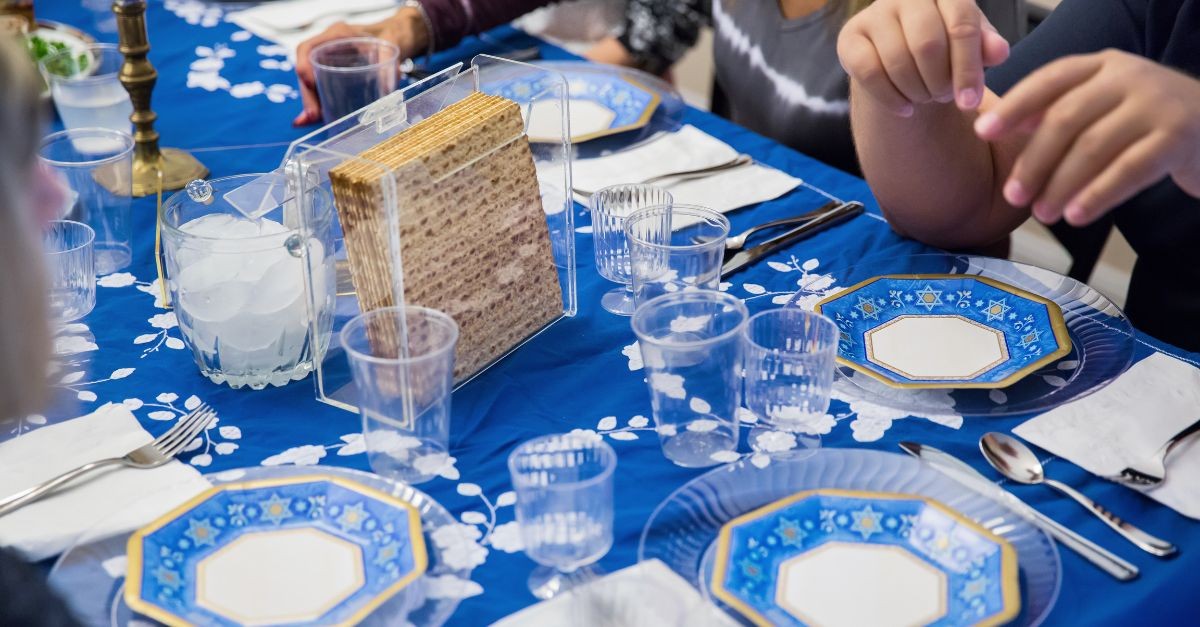
When God delivered Israel from Egypt’s slavery, he instituted a celebration to commemorate the event. As a judgment to Pharaoh and Egypt, God sent the angel of wrath to kill all the nation’s firstborn, both people and animals. To have this angel “pass over” a household and kill no one, God told the Israelites to kill a spotless lamb and spread the blood over the doorposts. Many died in Egypt, someone in every household, yet the Israelite firstborn survived the night. Pharaoh and Egypt kicked Israel out of the country.
Thousands of years later, the Son of God came in human form to live, die on the cross, and be resurrected once again. To institute this New Covenant, Jesus sat down with his disciples during Passover dinner and redefined this ancient celebration, bringing them deeper meaning from the elements and traditions.
As we celebrate Passover, we can discover Christ within the feast.
Here are seven things to remember about the Good News of Jesus this Passover.
Photo Credit: Getty Images/tomertu via CanvaPro
1. The Passover Lamb
Passover reveals Jesus as the Passover lamb. In the original Passover narrative recorded in Exodus, God told the Israelites to sacrifice a lamb and spread its blood on their doorposts to protect them from the death of the firstborn. This act of sacrifice and redemption prefigures the sacrificial death of Jesus, often referred to as the Lamb of God, whose blood brings salvation and liberation from sin and death.
Interestingly, Jesus’ crucifixion occurred around the same time the High Priest sacrificed the Passover lamb in the Temple. These same priests schemed to put the Lamb of God to death. When considering how they would kill him, the High Priest even said, “It’s better for one man to die than the whole nation.” (John 11:49-52) The High Priest worked for evil yet prophesied the atonement through Christ. The Apostle Paul draws a direct connection between the Passover lamb and Jesus in 1 Corinthians 5:7:
“For Christ, our Passover lamb, has been sacrificed.”
Here, Paul identifies Jesus as the ultimate fulfillment of the Passover symbolism, whose sacrificial death provides redemption and deliverance for all who believe in him. The innocence and purity of the Passover lamb foreshadow the sinlessness of Jesus, who, as the perfect and spotless Lamb of God, offers himself as a substitutionary sacrifice for humanity’s sins. Just as the blood of the Passover lamb protected the Israelites from the judgment of death, so too does the blood of Jesus provide forgiveness and atonement for believers.
2. Unleavened Bread
God told the Israelites to prepare to leave Egypt in haste when he delivered them from Pharaoh, so much so that he had them bake bread without any leaven. Leaven takes time to make the bread rise, which they didn’t have a margin for. In the Passover meal, unleavened bread, known as matzah, symbolizes purity, haste, and the Israelites’ departure from Egypt. This unleavened bread finds profound parallels in Jesus who identifies himself as the “bread of life.”
The night before his death, Jesus broke this unleavened bread during the Passover meal, redefining it as his body. “This is my body, broken for you.” (Luke 22:19) As believers, we live as strangers and aliens in this world, bound for a heavenly home. Acting with a longing for heaven, we partake in the person of Christ.
In John 6:35, Jesus declares, “I am the bread of life; whoever comes to me shall not hunger, and whoever believes in me shall never thirst.” Jesus establishes himself as the ultimate source of spiritual sustenance and nourishment, fulfilling the symbolism of the unleavened bread.
Jesus and the apostolic writings of the New Testament equate leaven with pride, so unleavened bread symbolizes our humility and authenticity. In 1 Corinthians 5:7-8, the Apostle Paul connects the Passover and Jesus, to “celebrate the festival, not with the old bread leavened with malice and wickedness, but with the unleavened bread of sincerity and truth.”

3. The Cup of Redemption
In the Passover, Jews partake in the Cup of Redemption. This cup, one of the four cups of wine traditionally consumed during the Passover Seder, holds significant prophetic implications and parallels with Jesus.
The Cup of Redemption symbolizes the blood of the Passover lamb and God’s deliverance of the Israelites from slavery in Egypt. This imagery foreshadows Jesus’ sacrificial death on the cross and the redemption he offers to humanity through his shed blood. In Matthew 26:27-28, during the Last Supper, Jesus takes the cup, gives thanks, and declares, “This is my blood of the covenant, which is poured out for many for the forgiveness of sins.”
Further, the modern Jewish Passover tradition includes the expectation of the coming of Elijah as a forerunner of the Messiah. In Malachi 4:5-6, the prophet Malachi speaks of the coming of Elijah before the great and dreadful day of the Lord. Many Jews traditionally set a place for Elijah at the Passover table, symbolizing their anticipation of the Messiah’s arrival. In the New Testament, Jesus identifies John the Baptist as the fulfillment of this prophecy, declaring in Matthew 11:14, “And if you are willing to accept it, he is the Elijah who was to come.”
This Cup of Redemption symbolizes the atoning blood of Jesus and the Messianic fulfillment in modern Jewish ceremonies. Christians also look forward to Christ’s coming again at the end of the age. God fulfilled his promise before, and he will again.
Photo Credit: ©Getty Images/stellalevi via Canva Pro
4. New Covenant
The original Passover established the Old Covenant, with deliverance leading to the giving of the La through Moses. However, on the night Jesus shared the meal with his disciples, he redefined the event and declared himself the New Covenant.
As recorded in Luke 22:20, Jesus takes the cup, saying, “This cup is the new covenant in my blood, which is poured out for you.” Here, Jesus establishes a new relationship between God and humanity, sealed with his own blood shed on the cross. This New Covenant offers forgiveness of sins and eternal life to all who believe in him.
The prophet Jeremiah prophesied about the New Covenant in Jeremiah 31:31-34, declaring that God would make a new covenant with his people, writing his law on their hearts and forgiving their sins. Jesus fulfills this prophecy through his sacrificial death and resurrection, ushering in a new era of grace and redemption. The Old Covenant gave a set of moral rules, a good and holy standard, yet the Law didn’t deal with the true issue—the heart. The Law may have been righteous, but humanity acts from an inward sinful nature. Therefore, no human being, even the chosen Israelites, could live by the Law.
On the cross, being both human and divine, Jesus put to death the sinful and inward rebellious nature. He effectively crucified sin and death and, upon rising again, made a way to live righteous and pleasing to God through faith.

5. Freedom from Slavery
In the Old Testament, the Passover commemorated God’s deliverance of the Israelites from slavery in Egypt, marking the transition from bondage to freedom through the miraculous intervention of God.
This liberation from physical slavery serves as a powerful foreshadowing of the spiritual freedom offered by Jesus Christ. In John 8:36, Jesus declares, “So if the Son sets you free, you will be free indeed.” Jesus offers freedom from the bondage of sin and death, providing liberation and new life to all who believe in him.
When we repent unto God, we are both set free and made free. To be set free speaks of outward chains on hands or a prison cell, which is one part. At the same time, Jesus makes us free from within. The Holy Spirit renews and regenerates our dead nature into a living one, now empowered to follow the divine. As Peter says, we’ve been made partakers of the divine nature (2 Peter 1:4). We couldn’t and can’t follow the divine life in our own strength. Christ frees us to live by the Spirit.
Furthermore, the Passover tradition emphasizes the importance of remembering God's deliverance and passing on this story to future generations. Similarly, believers in Jesus are called to remember and celebrate his sacrifice, which brings freedom and salvation to all who believe.
Photo Credit: Getty Images Signature/JodiJacobson via Canva Pro
6. Hiding the Afikomen
The Afikomen, a piece of matzah broken and hidden during the Passover meal, is a central element of the Seder ritual. During the meal, most modern Jews break a piece of matzah into three pieces. They hide the middle piece in a white napkin and hide it somewhere in the house. At the end of the meal, the adults send the children to find the Afikomen. Whichever child finds it gets a prize, usually chocolate.
Interestingly, sources point to this tradition developing centuries after Jesus, possibly to engage the children in what might be a boring meal by recounting the Exodus story and singing songs.
The three pieces of matzah reveal the Trinity. Matzah has both stripes and holes in it, signifying the whipping of Jesus’ body and the nails in his hands and feet.
This tradition mirrors Jesus’ burial after his crucifixion. Just as the Afikomen is hidden from sight during the Passover meal, so too was Jesus’ body hidden in the tomb. However, just as the Afikomen is later found and brought back to the table, Jesus triumphantly rose from the dead on the third day, conquering sin and death and bringing hope and salvation to all who believe in him. The finding of the hidden Afikomen, or Jesus rose from the dead, brings joy to children and adults alike.
7. Communion
In the Passover Seder, participants partake of unleavened bread and wine, symbolizing the haste of the Israelites’ departure from Egypt and their redemption through the blood of the sacrificial lamb.
Jesus, during the Last Supper, reinterprets these elements considering his impending sacrifice on the cross. As recorded in the Gospels, Jesus takes the bread, blesses it, and gives it to his disciples, saying, “This is my body, which is given for you; do this in remembrance of me” (Luke 22:19). He then takes the cup, blesses it, and says, “This cup that is poured out for you is the new covenant in my blood” (Luke 22:20). In this way, Jesus establishes a New Covenant sealed with his own blood, offering forgiveness of sins and eternal life to all who believe in him.
Through the act of communion, believers are invited to remember and proclaim the death and resurrection of Jesus Christ until his return. As Paul writes in 1 Corinthians 11:26, “For as often as you eat this bread and drink the cup, you proclaim the Lord's death until he comes.” And just like the Passover meal happens with family and friends, Jesus' followers gather with the church and partake in communion, not alone. Communion serves as a tangible expression of fellowship with Christ and fellow believers, as well as a celebration of the redemptive work accomplished through Jesus’ sacrificial death and resurrection.
This year, if you celebrate Passover, take the time to recognize the depth of meaning within the meal and the ceremony. For Christians, we can give God praise for both what he did to deliver the Israelites and what he did for the world through Jesus two thousand years ago. Scripture has many levels of meaning and complexity, giving life and connecting us to the redemptive story God is telling throughout history. His story of deliverance and reconciliation culminates in the gathering of all believers in another meal, the wedding supper of the Lamb.

Originally published Tuesday, 23 April 2024.
